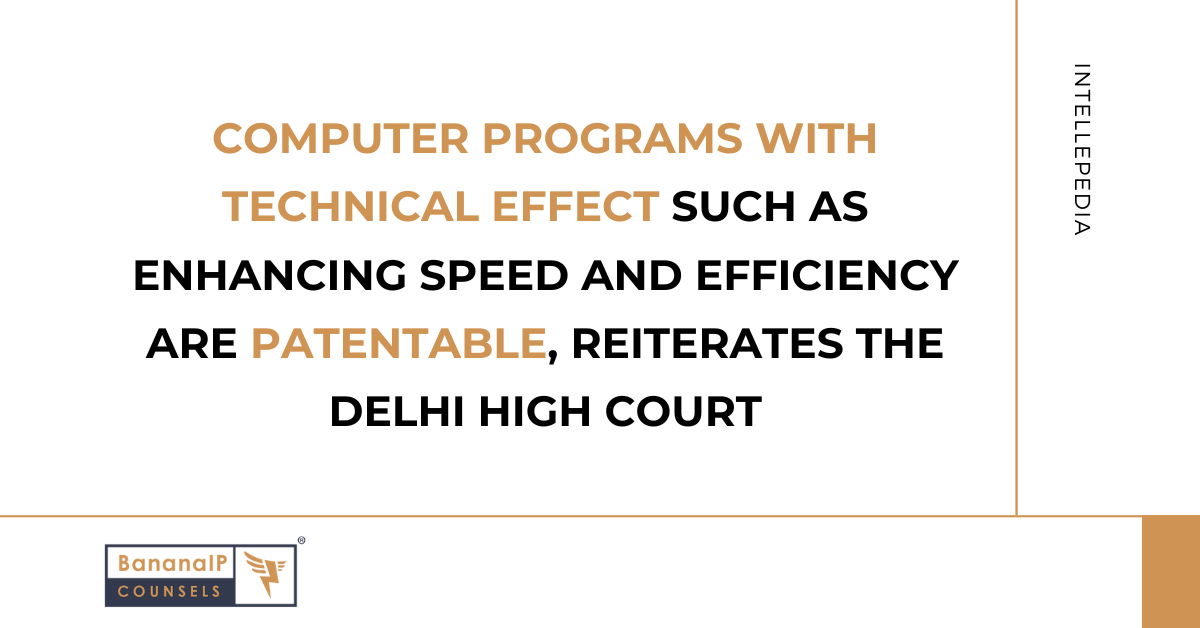The 2025 Draft CRI Guidelines issued by the Indian Patent Office refine the criteria for patentability of Computer Related Inventions (CRIs), emphasizing technical effect, inventive step, sufficiency of disclosure, and proper claim drafting for AI, blockchain, and emerging technologies.
Read more about From Algorithms To AI: Patentability Under The 2025 CRI Draft GuidelinesTag: Section 3(k)
Evaluation of Technical Advancement and Compliance with CRI Guidelines under Indian Patent Law
The Madras High Court allowed Idemia Identity & Security France’s appeal, setting aside a refusal order under Section 3(k) for a cryptography patent. The Court ruled the order as a non-speaking one and in violation of natural justice. It directed fresh consideration of the matter, emphasizing technical contributions and adherence to CRI and European guidelines.
Read more about Evaluation of Technical Advancement and Compliance with CRI Guidelines under Indian Patent LawBlackberry blacks out in case relating to patentability of algorithmic processes
This article analyzes India’s legal stance on the patentability of algorithmic processes under Section 3(k) of the Patents Act, 1970. Focusing on the Delhi High Court’s judgment in Blackberry Limited vs. Assistant Controller of Patents and Designs, the post explores key arguments, legal precedents, and implications for software patents in India.
Read more about Blackberry blacks out in case relating to patentability of algorithmic processesComputer Programs with Technical Effect such as enhancing speed and efficiency are patentable, reiterates the Delhi High Court
In an appeal decision, the Delhi High Court recently overturned the rejection of two patent applications filed by Ab Initio Technology LLC, concerning data processing...
Read more about Computer Programs with Technical Effect such as enhancing speed and efficiency are patentable, reiterates the Delhi High CourtCourt criticizes Patent Office for using outdated CRI Guidelines
The Madras High Court criticized the Patent Office for using outdated CRI guidelines of 2016 instead of the revised 2017 guidelines in evaluating Microsoft’s patent application. The court emphasized the importance of assessing technical effect or contribution in CRIs without considering hardware.
Read more about Court criticizes Patent Office for using outdated CRI GuidelinesA Deep Dive into Section 3(k) Analysis of Ericsson’s Eight Patents – Ericsson vs. Lava – Part VII
This post analyzes an Indian court case between Ericsson and Lava focusing on Section 3(k) of the Patents Act. This section prohibits patents on mathematical methods, business methods, computer programs, and algorithms. The court evaluated the patentability of eight patents related to mobile communication technologies under Section 3(k).
Read more about A Deep Dive into Section 3(k) Analysis of Ericsson’s Eight Patents – Ericsson vs. Lava – Part VIISection 3(k) principles – Ericsson vs. Lava – Part 2
While Part 1 of the Ericsson vs. Lava post series covered the summary of the court's judgement, this post discusses the principles reiterated by the...
Read more about Section 3(k) principles – Ericsson vs. Lava – Part 2Is a system for ‘Selectively Displaying Physical Address’ unpatentable as a business method?
Learn how a system for concealing user addresses in online transactions was deemed patentable, distinguishing it from excluded “business methods.” Gain insights for navigating patent applications in the digital age.
Read more about Is a system for ‘Selectively Displaying Physical Address’ unpatentable as a business method?Refusal of Patent for “Image Construction Apparatus” based on Section 3(k) and Inventive Step set aside by the Madras High Court
Madras High Court overturned patent refusal for “Image Construction Apparatus” due to insufficient reasoning from the Controller regarding inventive step and Section 3(k). The Court criticized failure to consider the fact that the European Patent Office (EPO) had granted a patent based on the same prior art references and the disregard to analyze technical aspects per Section 3(k).
Read more about Refusal of Patent for “Image Construction Apparatus” based on Section 3(k) and Inventive Step set aside by the Madras High CourtNew Computer Related Inventions Guidelines
The Indian Patent Office, after extensive consultative process, has issued an Order by which Chapter 08.03.05.10 of the Manual of Patent Office Practice and...
Read more about New Computer Related Inventions Guidelines








